Study on the Effects of the Hydrogen Substitution Rate on the Performance of a Hydrogen–Diesel Dual-Fuel Engine under Different Loads
Abstract
:1. Introduction
2. Test Device and Test Method
2.1. Test Device
2.2. Test Method
2.3. Measurement Calculation Formula
3. Results and Discussions
3.1. Influence of Hydrogen Substitution Rate in Various Loads
3.1.1. Analysis of Combustion Characteristics
3.1.2. Economic Analysis
3.1.3. Analysis of Emission Characteristics
3.2. Impact of EGR Rate
3.2.1. Analysis of Combustion Characteristics
3.2.2. Economic Analysis
3.2.3. Analysis of Emission Characteristics
3.3. Impact of Main Injection Timing
3.3.1. Analysis of Combustion Characteristics
3.3.2. Economic Analysis
3.3.3. Analysis of Emission Characteristics
4. Conclusions
- The larger the load, the smaller the maximum hydrogen substitution rate that can be added. Under each load, compared to pure diesel, as the hydrogen substitution rate increases, the combustion becomes stronger, the flame-propagation speed becomes faster, the peak cylinder pressure and HRR both increase and the corresponding peak phase shifts forward. The BSFCequ has decreased, with a maximum reduction of 4.5% and a minimum BSFCequ of 196.57 g/(kW·h). The thermal efficiency has increased, with a maximum increase of 4.6% and a maximum thermal efficiency of 43.1%. CO2 emissions decreased by a maximum reduction of 35.2%, while NOx emissions decreased at medium to low loads, while at high loads, the maximum increase was 20.1%;
- With the increase of the EGR rate, more exhaust gas is introduced, resulting in a decrease in oxygen content and temperature in the cylinder. The peak cylinder pressure and HRR both decrease and the corresponding peak phase moves backward, the BSFCequ increases, and the thermal efficiency decreases, with a maximum decrease of 1.3%. CO2 emissions have increased, with a maximum increase of 6.6%. NOx emissions have decreased, with a maximum reduction of 63.1%;
- With the advance of main injection timing, the mixture formed early near TDC to participate in combustion, the peak cylinder pressure and HRR both increase, and the corresponding peak phases move forward, the BSFCequ decreases, and the thermal efficiency increases, with the maximum increase of 8.5%. CO2 emissions decrease and NOx emissions increase, with a maximum increase of 44.5%. Therefore, NOx emissions in a dual-fuel engine can be reduced by increasing the EGR rate and delaying main injection timing.
Author Contributions
Funding
Conflicts of Interest
Nomenclature
| BSFCequ | equivalent brake-specific fuel consumption |
| EGR | exhaust-gas recirculation |
| TDC | top dead center |
| ATDC | after top dead center |
| CO2 | carbon dioxide |
| NOx | nitrogen oxide |
| HRR | heat release rate |
References
- Yu, W.; Yang, T. The generation mechanism of diesel engine emissions and technical measures to reduce emissions. Transp. Energy Conserv. Environ. Prot. 2007, 3, 17–19. [Google Scholar]
- Nag, S.; Sharma, P.; Gupta, A.; Dhar, A. Combustion, vibration and noise analysis of hydrogen-diesel dual-fuelled engine. Fuel 2019, 241, 488–494. [Google Scholar] [CrossRef]
- Yang, B.; Ning, L.; Liu, B.; Huang, G.; Cui, Y.; Zeng, K. Comparison study the particulate matter characteristics in a diesel/natural gas dual-fuel engine under different natural gas-air mixing operation conditions. Fuel 2020, 288, 119721. [Google Scholar] [CrossRef]
- Verma, S.; Suman, A.; Das, L.M.; Kaushik, S.C.; Tyagi, S.K. A renewable pathway towards increased utilization of hydrogen in diesel engines. Int. J. Hydrogen Energy 2019, 45, 5577–5587. [Google Scholar] [CrossRef]
- Agarwal, A.K.; Guota, J.G.; Dhar, A. Potential and challenges for large-scale application of biodiesel in automotive sector. Prog. Energy Combust. Sci. 2017, 61, 113–149. [Google Scholar] [CrossRef]
- Saccullo, M.; Nygren, A.; Benham, T.; Denbratt, I. Alcohol flexible HD single cylinder diesel engine tests with separate dual high pressure direct fuel injection. Fuel 2021, 294, 120478. [Google Scholar] [CrossRef]
- Loganathan, M.; Velmurugan, A.; Page, T.; Gunasekaran, E.J.; Tamilarasan, P. Combustion analysis of a hydrogen-diesel fuel operated DI diesel engine with exhaust gas recirculation. Front. Energy 2017, 11, 568–574. [Google Scholar] [CrossRef]
- Sunil, K.R.; Vaibhav, S.D. Kinetic analysis of the role of selective NOx recirculation in reducing NOx emissions from a hydrogen engine. Chem. Eng. J. 2019, 377, 20–23. [Google Scholar]
- Jiang, D.H.; Ning, Z.A. Study on the Combustion and Emission Characteristics of Premixed Hydrogen/Diesel Engines. In Proceedings of the Second Postgraduate Academic Forum of School of Mechanical and Electronic Control Engineering. Combust. Sci. Technol. 2007, 16, 231–234. [Google Scholar]
- Tsujimura, T.; Suzuki, Y. The utilization of hydrogen in hydrogen/diesel dual-fuel engine. Int. J. Hydrogen Energy 2017, 42, 14019–14029. [Google Scholar] [CrossRef]
- White, C.M.; Steeper, R.R.; Lutz, A.E. The hydrogen-fueled internal combustion engine: A technical review. Int. J. Hydrogen Energy 2006, 31, 1292–1305. [Google Scholar] [CrossRef]
- Mohammadi, A.; Shioji, M.; Nakai, Y.; Ishikura, W.; Tabo, E. Performance and combustion characteristics of a direct injection SI hydrogen engine. Int. J. Hydrogen Energy 2007, 32, 296–304. [Google Scholar] [CrossRef]
- Mathur, H.B.; Das, L.M.; Patro, T.N. Hydrogen-fuelled diesel engine: Performance improvement through charge dilution techniques. Int. J. Hydrogen Energy 1993, 18, 421–431. [Google Scholar] [CrossRef]
- Patro, T.N. Combustion study of hydrogen fueled DI diesel engine: Simplified heat release analysis. Int. J. Hydrogen Energy 1993, 18, 231–241. [Google Scholar] [CrossRef]
- Aleiferis, P.G.; Rosati, M.F. Controlled autoignition of hydrogen in a direct-injection optical engine. Combust. Flame 2012, 159, 2500–2515. [Google Scholar] [CrossRef] [Green Version]
- Gutarevych, Y.; Shuba, Y.; Matijošius, J.; Karev, S.; Sokolovskij, E.; Rimkus, A. Intensification of the combustion process in a gasoline engine by adding a hydrogen-containing gas. Int. J. Hydrogen Energy 2018, 43, 16334–16343. [Google Scholar] [CrossRef]
- Karagöz, Y.; Balcı, Ö.; Köten, H. Investigation of hydrogen usage on combustion characteristics and emissions of a spark ignition engine. Int. J. Hydrogen Energy 2019, 44, 14243–14256. [Google Scholar] [CrossRef]
- Naruke, M.; Morie, K.; Sakaida, S.; Tanaka, K.; Konno, M. Effects of hydrogen addition on engine performance in a spark ignition engine with a high compression ratio under lean burn conditions. Int. J. Hydrogen Energy 2019, 44, 15565–15574. [Google Scholar] [CrossRef]
- Gatts, T.; Liu, S.; Liew, C.; Ralston, B.; Bell, C.; Li, H. An experimental investigation of incomplete combustion of gaseous fuels of a heavy-duty diesel engine supplemented with hydrogen and natural gas. Int. J. Hydrogen Energy 2012, 37, 7848–7859. [Google Scholar] [CrossRef]
- Singh, A.P.; Pal, A.; Agarwal, A.K. Comparative particulate characteristics of hydrogen, CNG, HCNG, gasoline and diesel fueled engines. Fuel 2016, 185, 491–499. [Google Scholar] [CrossRef]
- Szwaja, S.; Grab-Rogalinski, K. Hydrogen combustion in a compression ignition diesel engine. Int. J. Hydrogen Energy 2009, 34, 4413–4421. [Google Scholar] [CrossRef]
- Jafarmadar, S. Exergy analysis of hydrogen/diesel combustion in a dual-fuel engine using three-dimensional model. Int. J. Hydrogen Energy 2014, 39, 9505–9514. [Google Scholar] [CrossRef]
- Menaa, A.; Lounici, M.S.; Amrouche, F.; Loubar, K.; Kessal, M. CFD analysis of hydrogen injection pressure and valve profile law effects on backfire and preignition phenomena in hydrogen-diesel dual-fuel engine. Int. J. Hydrogen Energy 2019, 44, 9408–9422. [Google Scholar] [CrossRef]
- Yang, Z.; Hai, L. Emission characteristics of the 2004 Mack MD11 diesel engine fueled with hydrogen diesel hybrid fuel. J. Agric. Eng. 2012, 28, 39–43. [Google Scholar]
- Adnan, R.; Masjuki, H.; Mahlia, T. Performance and emission analysis of hydrogen fueled compression ignition engine with variable water injection timing. Energy 2012, 43, 416–426. [Google Scholar] [CrossRef]
- Naber, J.; Szwaja, S. Statistical approach to characterize combustion knock in the hydrogen fuelled SI engine. J. Kones Power. Transp. 2007, 14, 443–450. [Google Scholar]
- Naber, J.; Siebers, D. Hydrogen combustion under diesel engine conditions. Int. J. Hydrogen Energy 1998, 23, 363–371. [Google Scholar] [CrossRef]
- Li, L.; Yu, Y.; Lin, W. Numerical investigation on the effects of load conditions and hydrogen-air ratio on the combustion processes of a HSDI engine. Int. J. Hydrogen Energy 2020, 45, 10602–10612. [Google Scholar] [CrossRef]
- Huang, B.; Hu, E.; Huang, Z.; Zheng, J.; Liu, B.; Jiang, D. The cyclic variation law of spark ignition natural gas hydrogen blended engine combined with EGR. J. Intern. Combust. Engines 2011, 29, 16–22. [Google Scholar]
- Bose, P.K.; Maji, D. An experimental investigation on engine performance and emissions of a single cylinder diesel engine using hydrogen as inducted fuel and diesel as injected fuel with exhaust gas recirculation. Int. J. Hydrogen Energy 2009, 34, 4701–4707. [Google Scholar] [CrossRef]
- Singhyadav, V.; Soni, S.L.; Sharma, D. Performance and emission studies of direct injection C.I. engine in duel fuel mode (hydrogen-diesel) with EGR. Int. J. Hydrogen Energy 2012, 37, 3807–3817. [Google Scholar] [CrossRef]
- Dimitriou, P.; Kumar, M.; Tsujimura, T.; Suzuki, Y. Combustion and emission characteristics of a hydrogen-diesel dual-fuel engine. Int. J. Hydrogen Energy 2018, 43, 13605–13617. [Google Scholar] [CrossRef]
- Yu, X.; Wu, H.; Du, Y.; Liu, L.; Niu, R.; Dong, W. Study on the synergistic effect of hydrogen direct injection and EGR on combustion and emissions of gasoline engines. Automot. Eng. 2016, 38, 1044–1051. [Google Scholar]
- Wu, H.; Wu, Z. Investigation on combustion characteristics and emissions of diesel/hydrogen mixtures by using energy-share method in a diesel engine. Appl. Therm. Eng. 2012, 42, 154–162. [Google Scholar] [CrossRef]
- Miyamoto, T.; Hasegawa, H.; Mikami, M.; Kojima, N.; Kabashima, H.; Urata, Y. Effect of hydrogen addition to intake gas on combustion and exhaust emission characteristics of a diesel engine. Int. J. Hydrogen Energy 2011, 36, 13138–13149. [Google Scholar] [CrossRef]
- Tomita, E.; Kawahara, N.; Piao, Z.; Fujita, S.; Hamamoto, Y. Hydrogen Combustion and Exhaust Emissions Ignited with Diesel Oil in a Dual-Fuel Engine; SAE Technical Paper; SAE: Okayama City, Japan, 2001. [Google Scholar]
- Tripathi, G.; Sharma, P.; Dhar, A.; Sadiki, A. Computational investigation of diesel injection strategies in hydrogen-diesel dual-fuel engine. Sustain. Energy Technol. Assess. 2018, 43, 782–796. [Google Scholar] [CrossRef]
- Ghazal, O.H. Combustion analysis of hydrogen-diesel dual-fuel engine with water injection technique. Case Stud. Therm. Eng. 2019, 13, 100380. [Google Scholar] [CrossRef]
- Zhou, L.B. Internal Combustion Engine, 2nd ed.; Beijing Machinery Industry Press: Beijing, China, 2005; pp. 268–285. [Google Scholar]
- Li, R.; Wang, Z.; Zhang, D.; Li, M. The effect of exhaust gas recirculation on the combustion process of a high proportion methanol dual-fuel diesel engine. Automot. Eng. 2014, 11, 1360–1364. [Google Scholar]
- Chen, G.; Wei, F.; Li, B.; Wang, Z.; Huang, Z.; Luo, Y. The effect of different intake atmospheres coupled with exhaust gas recirculation on the working process of dual-fuel engine. Intern. Combust. Engine Eng. 2022, 43, 1–11. [Google Scholar]
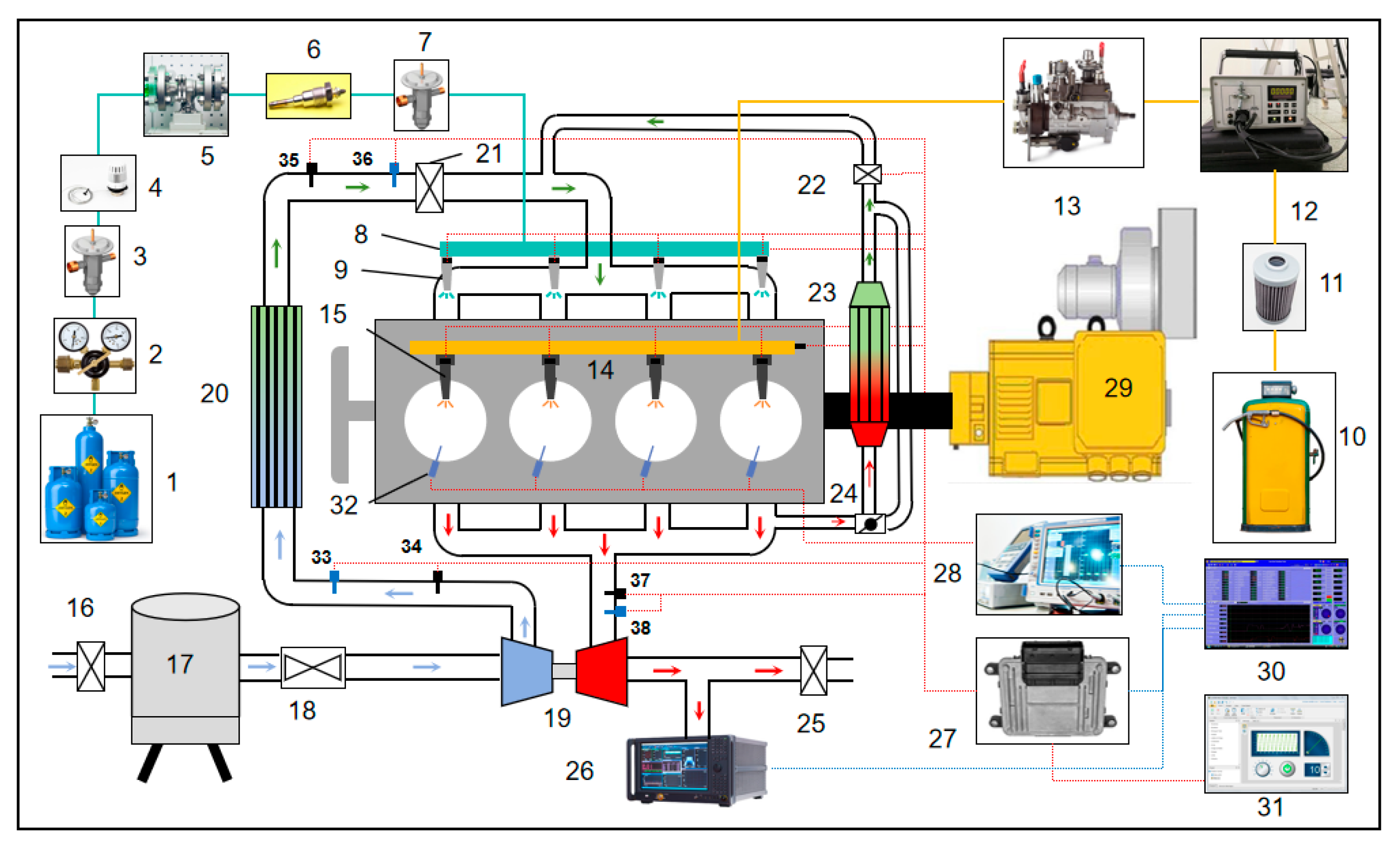
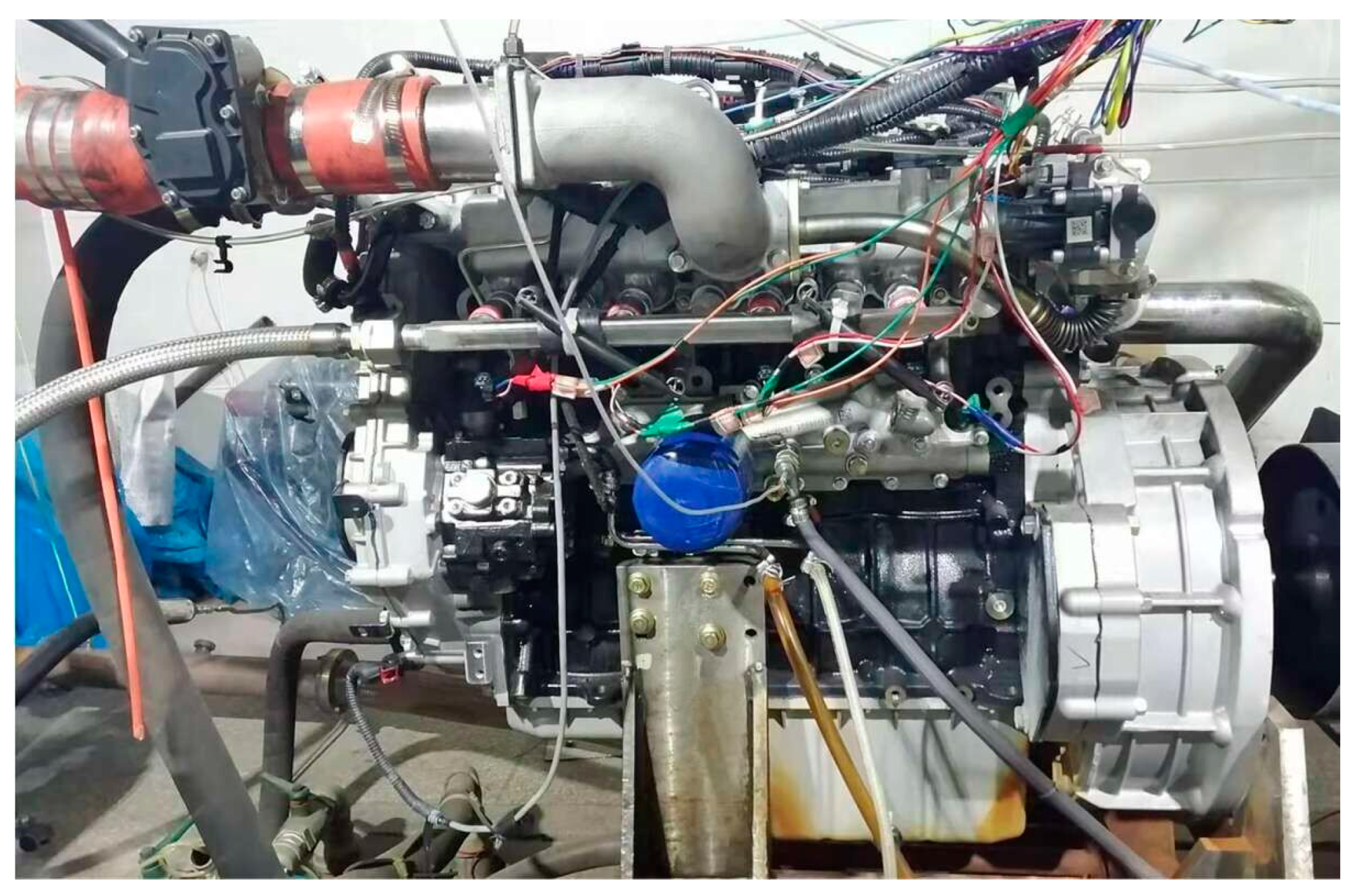
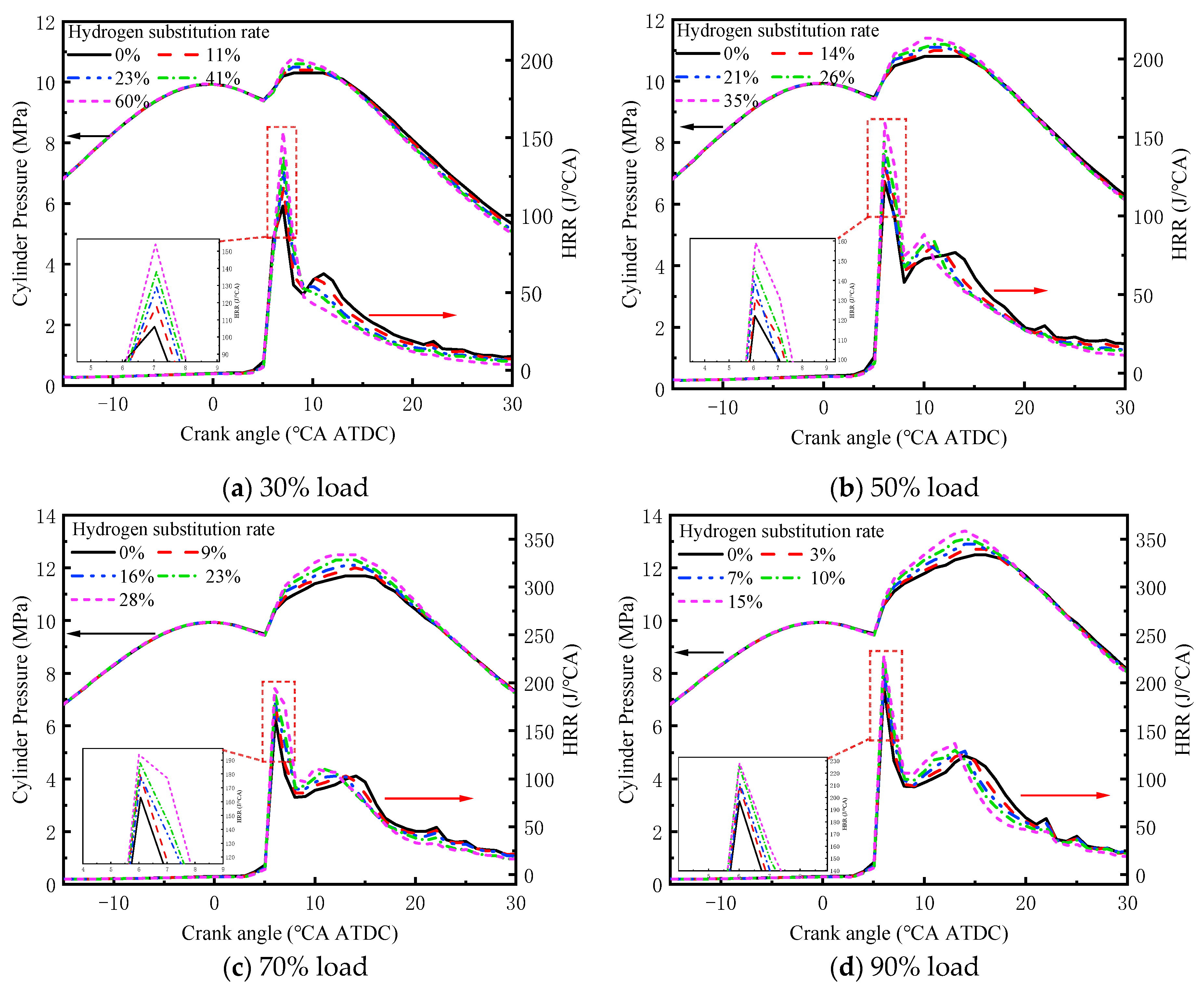

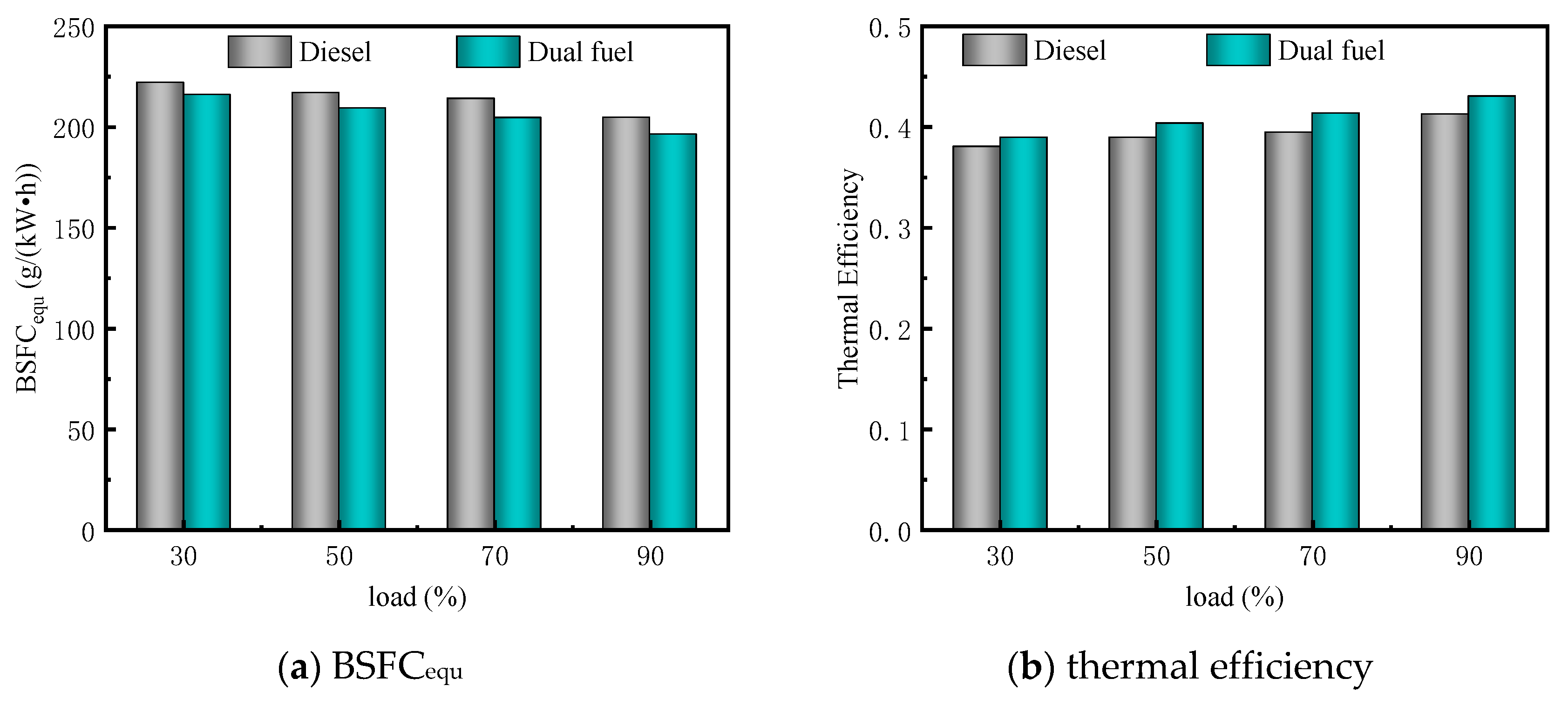
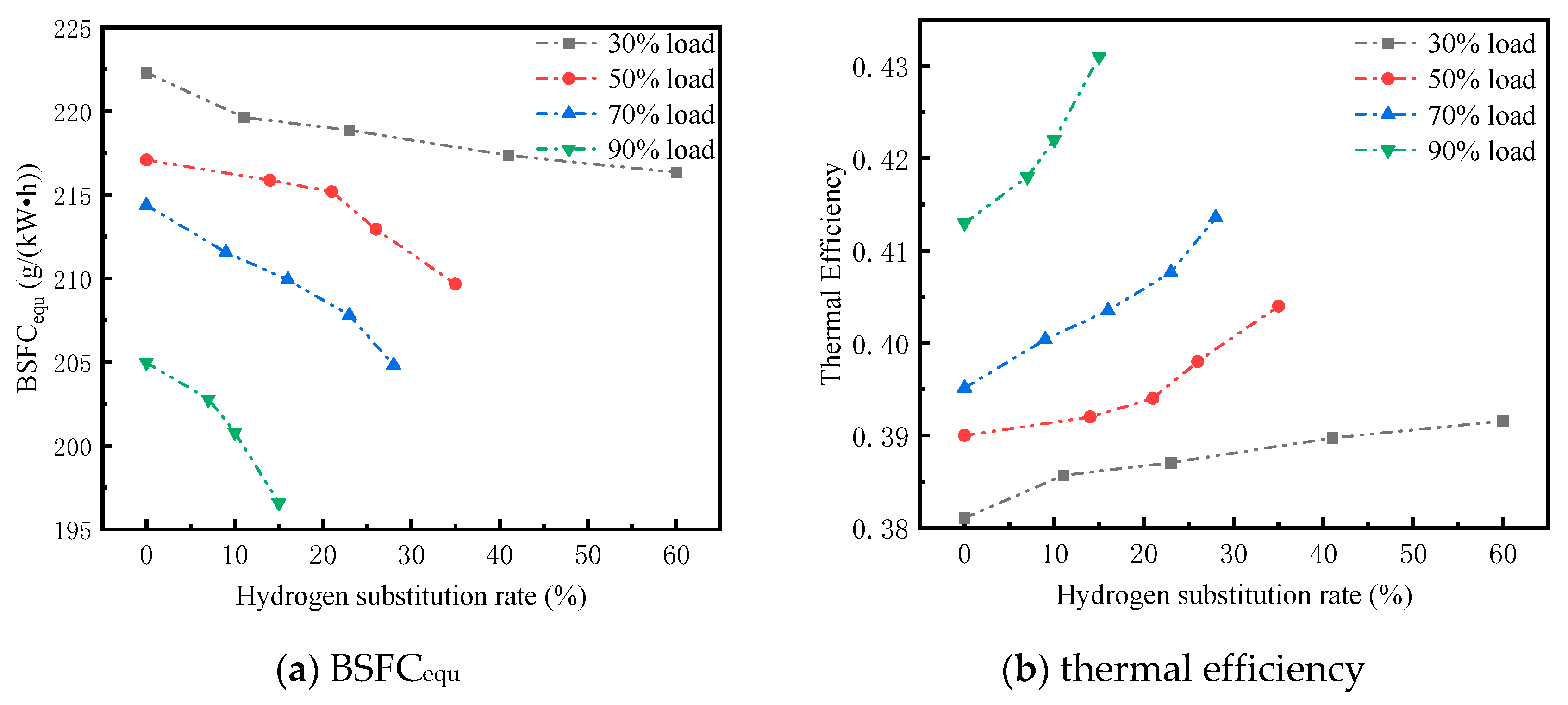
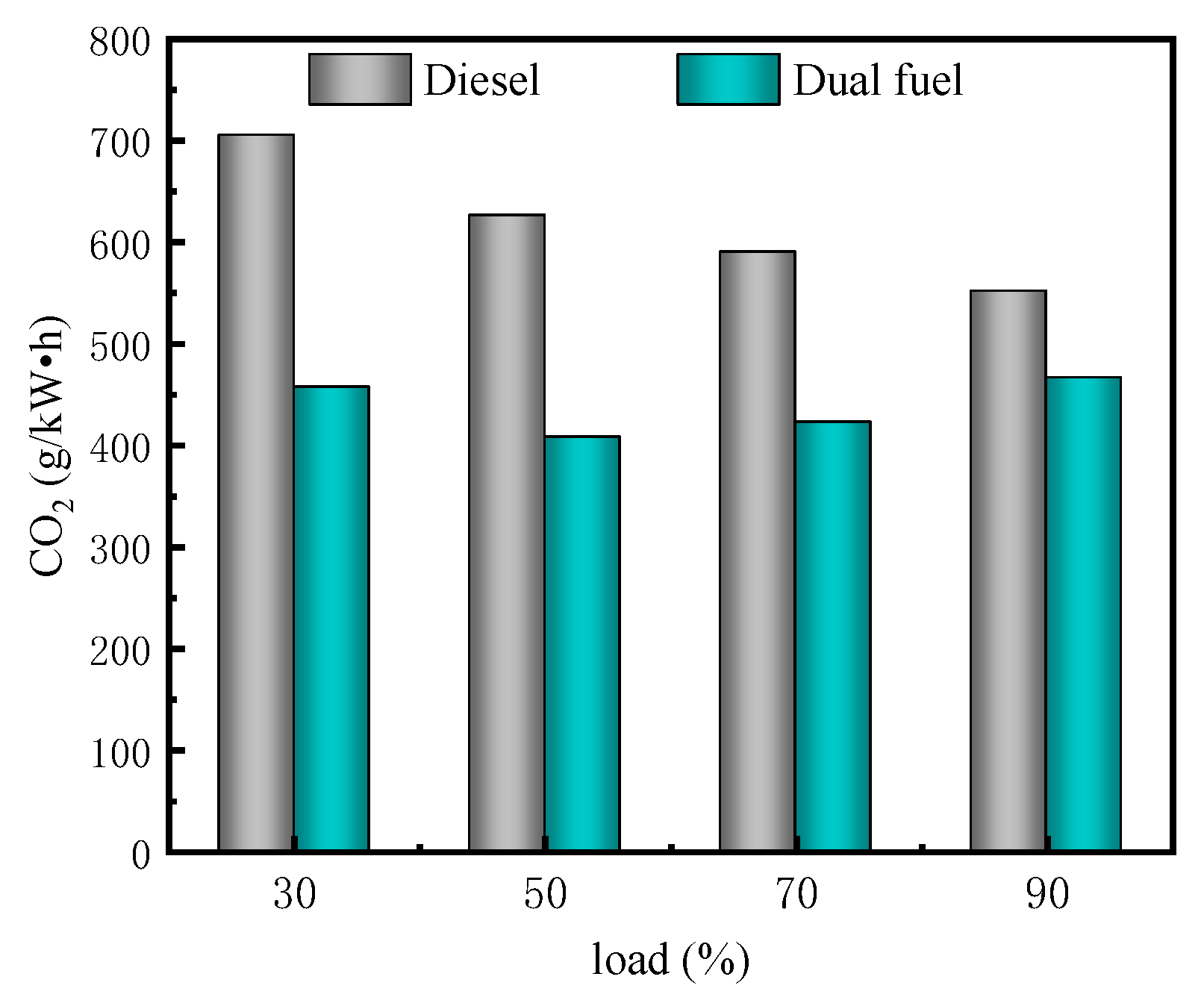
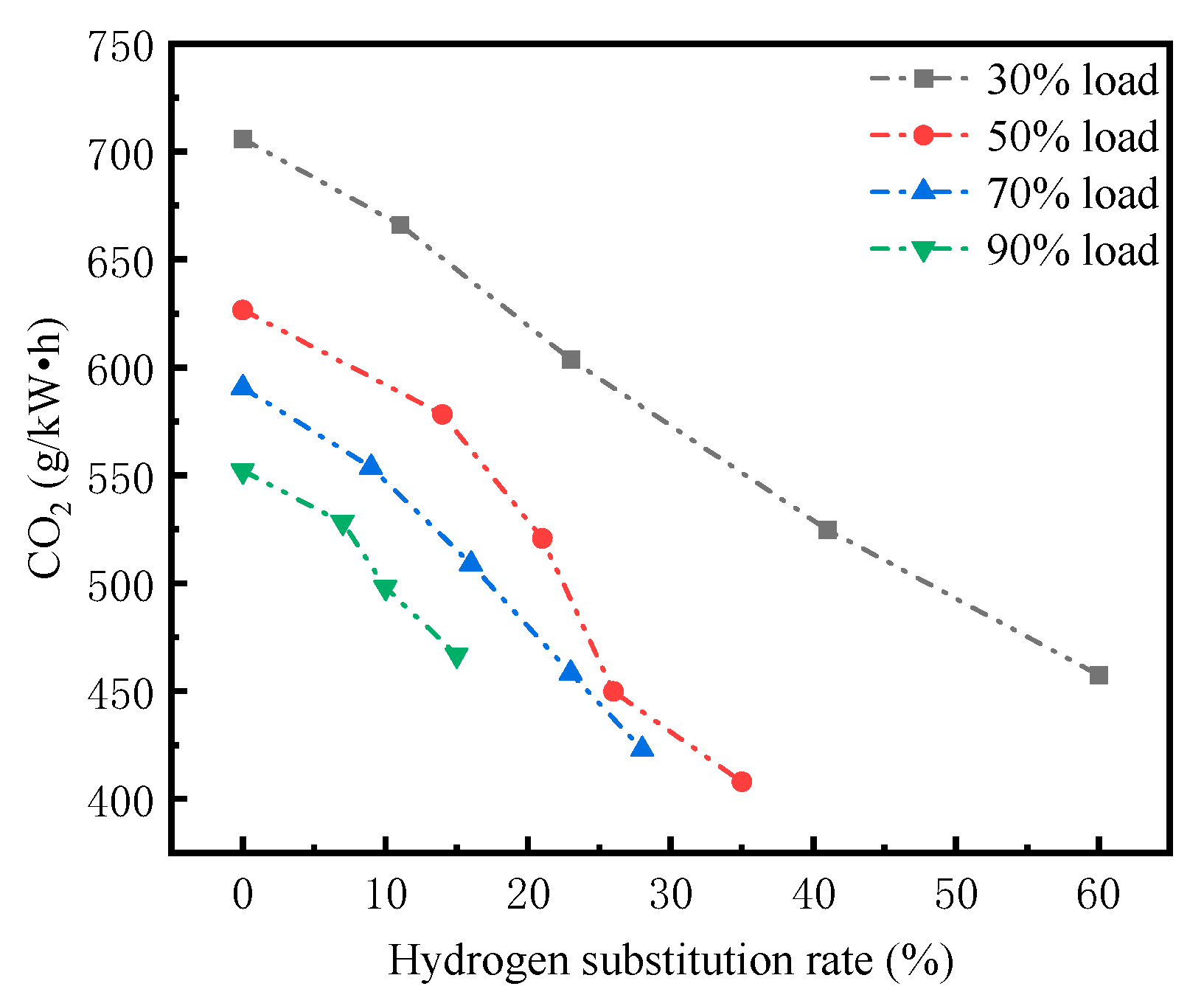
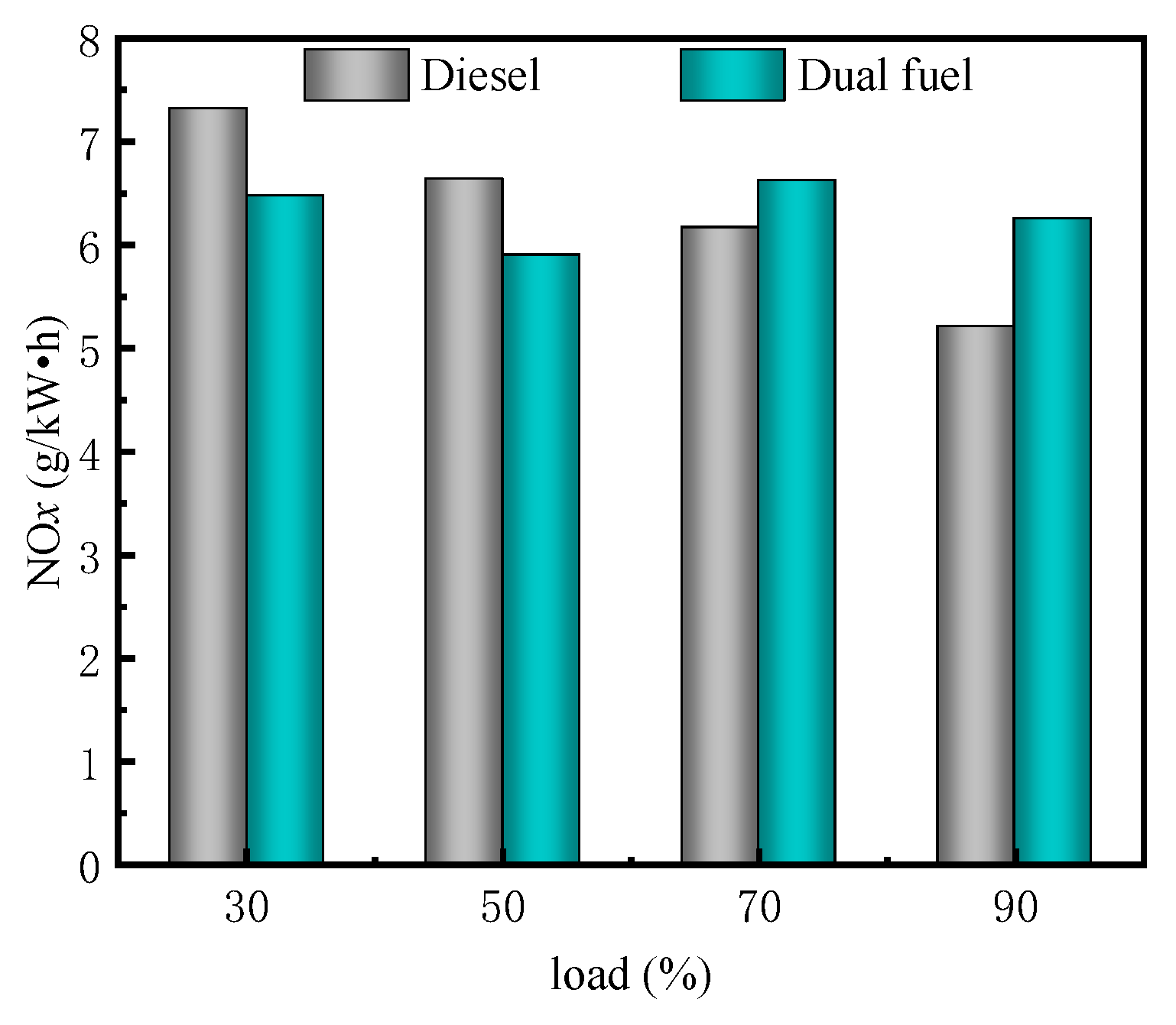


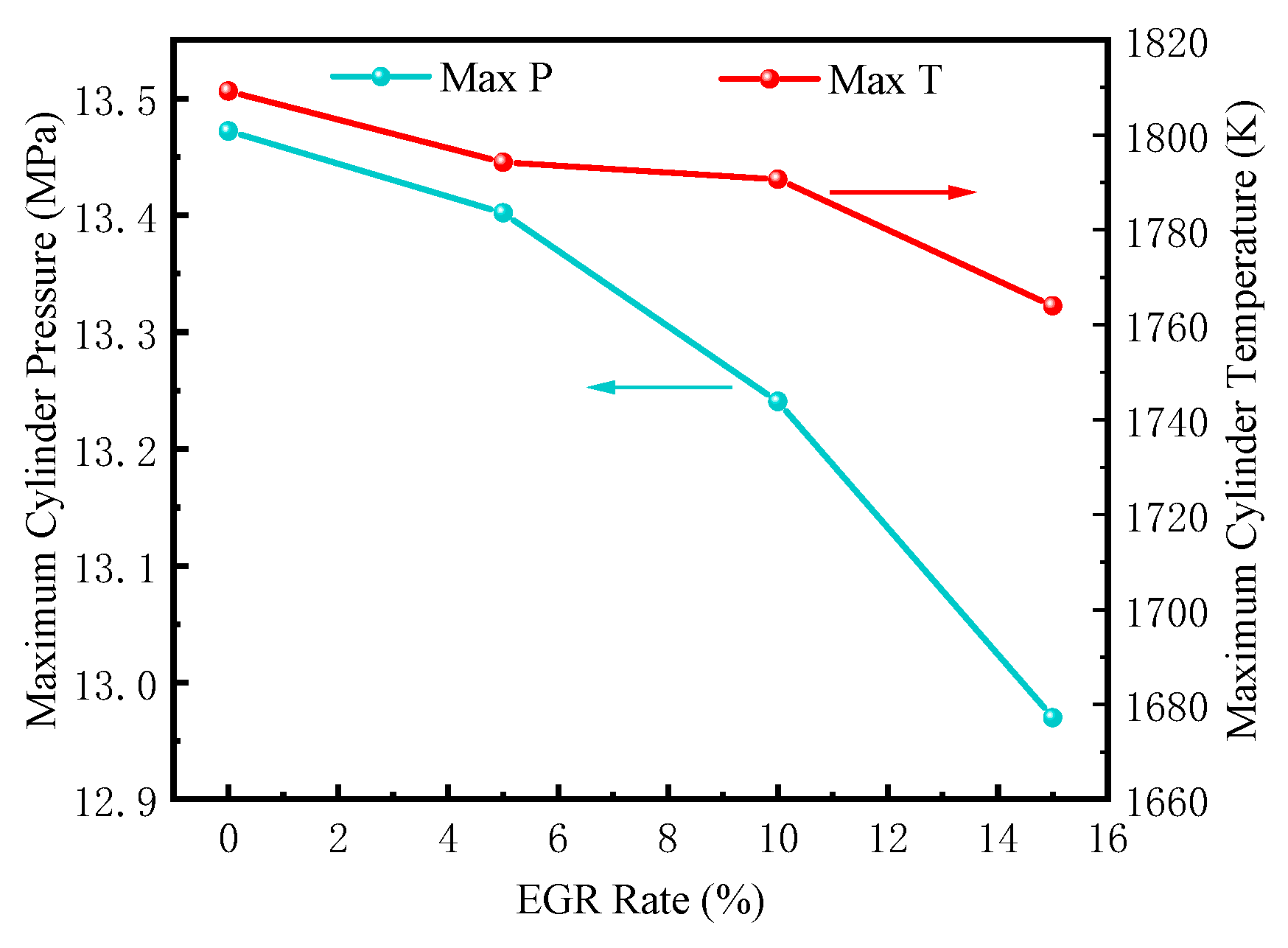

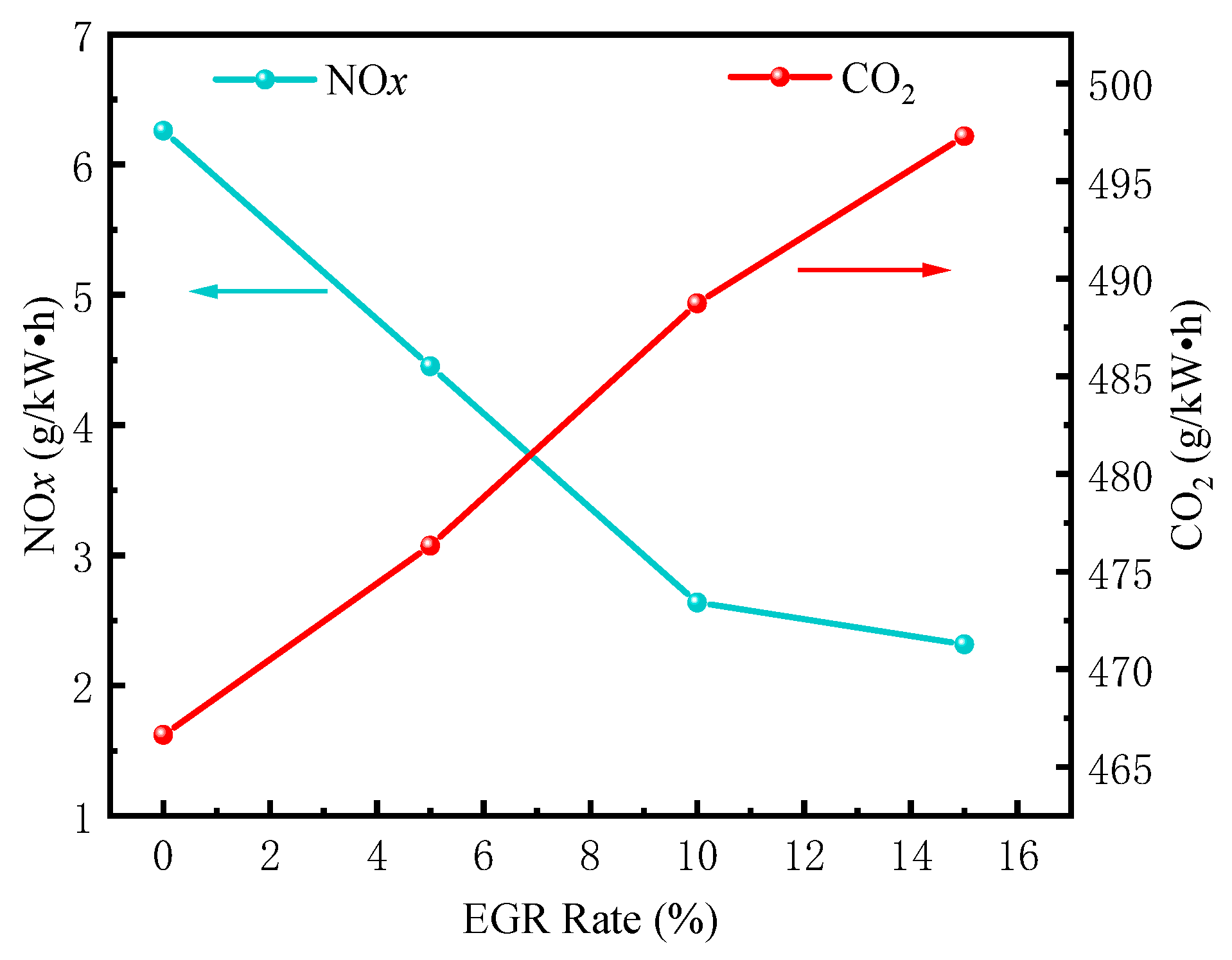
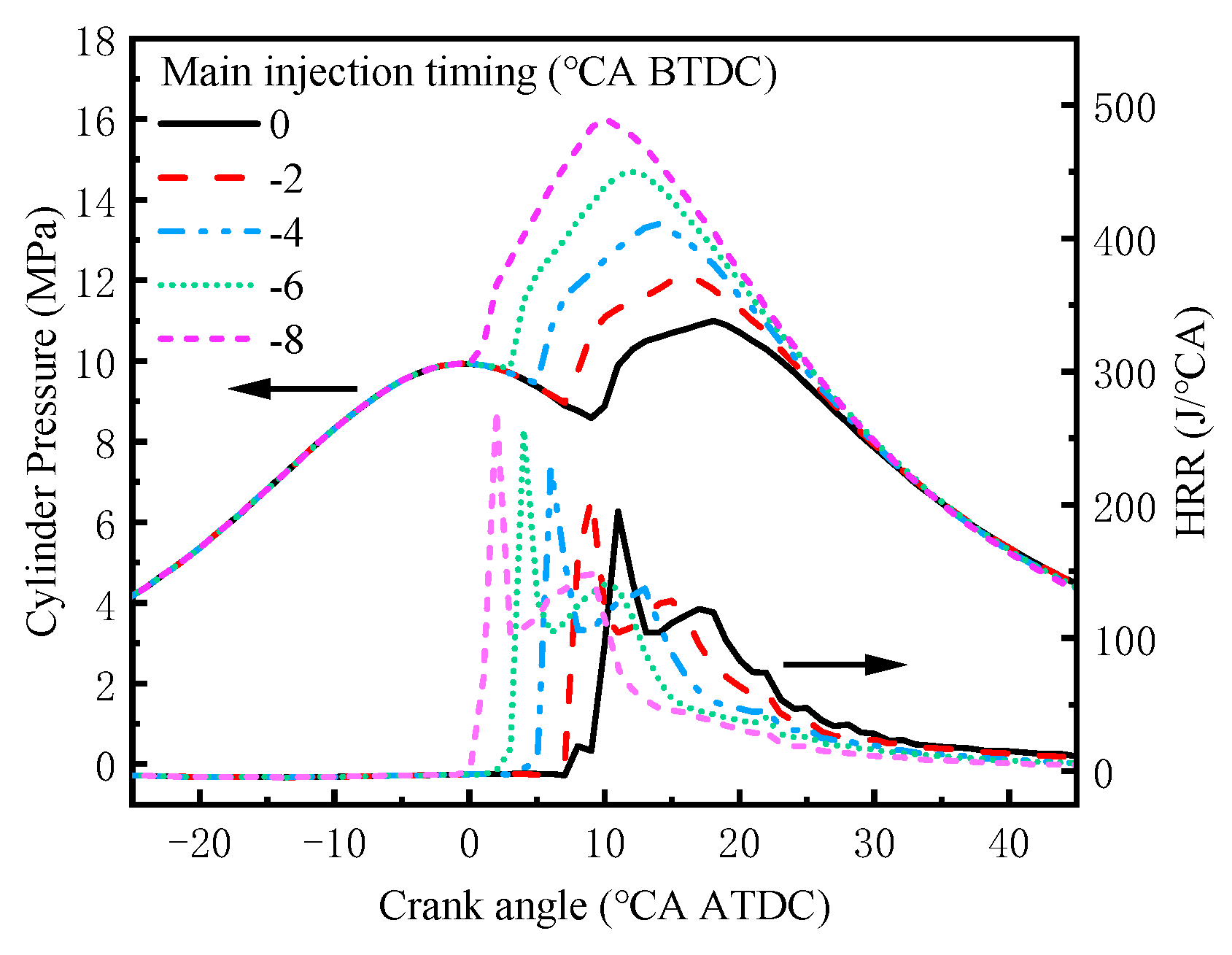
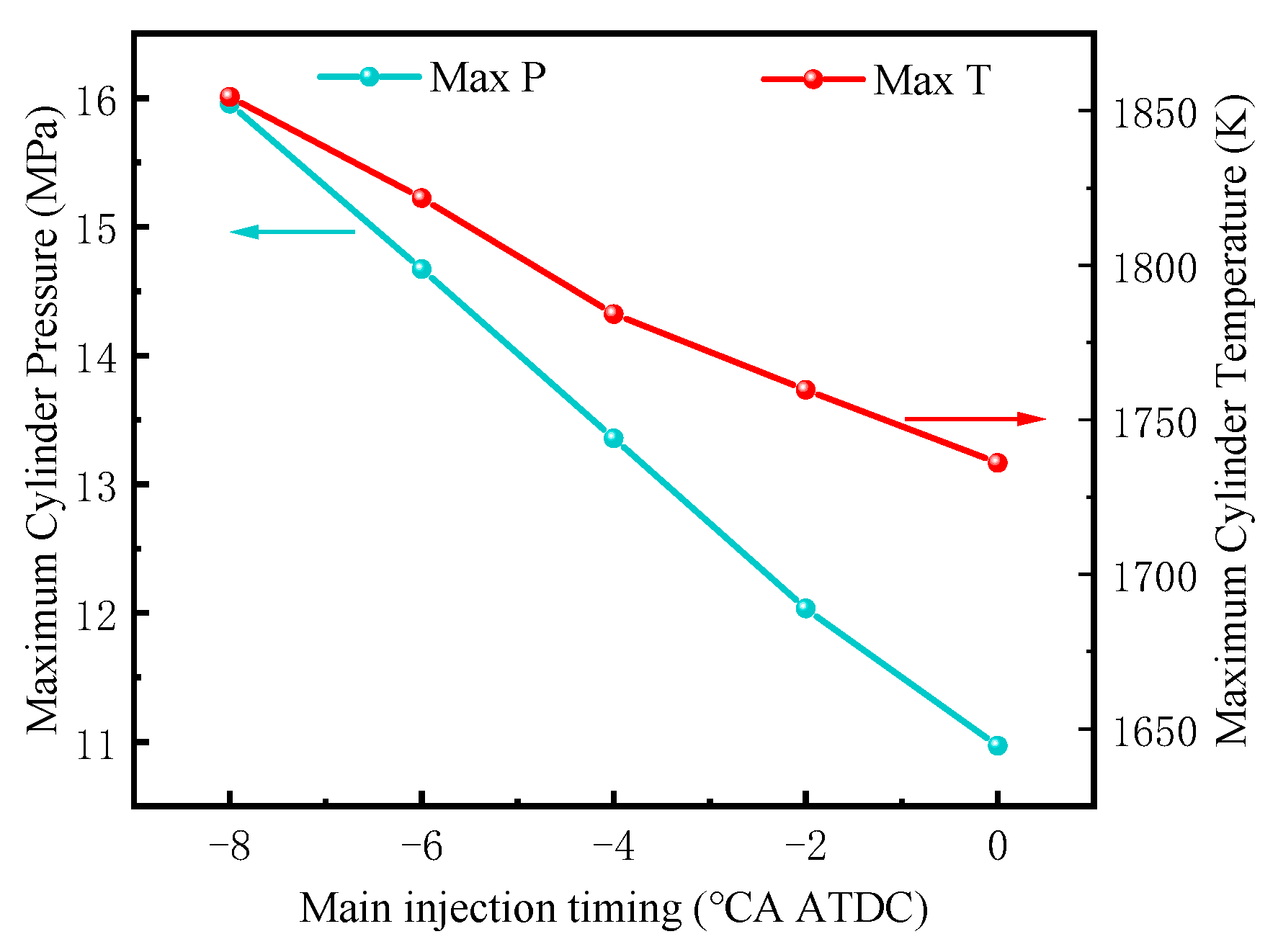
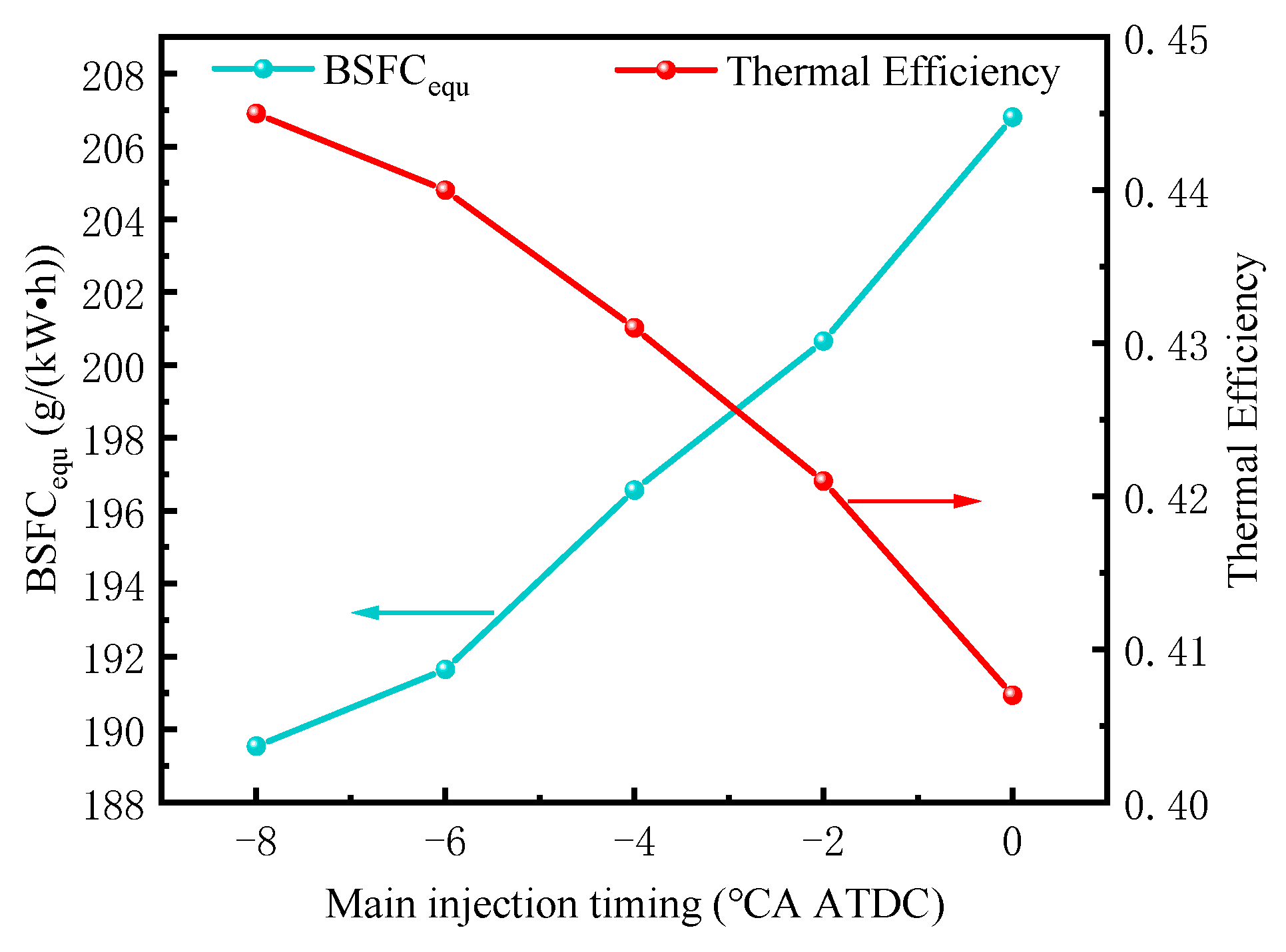
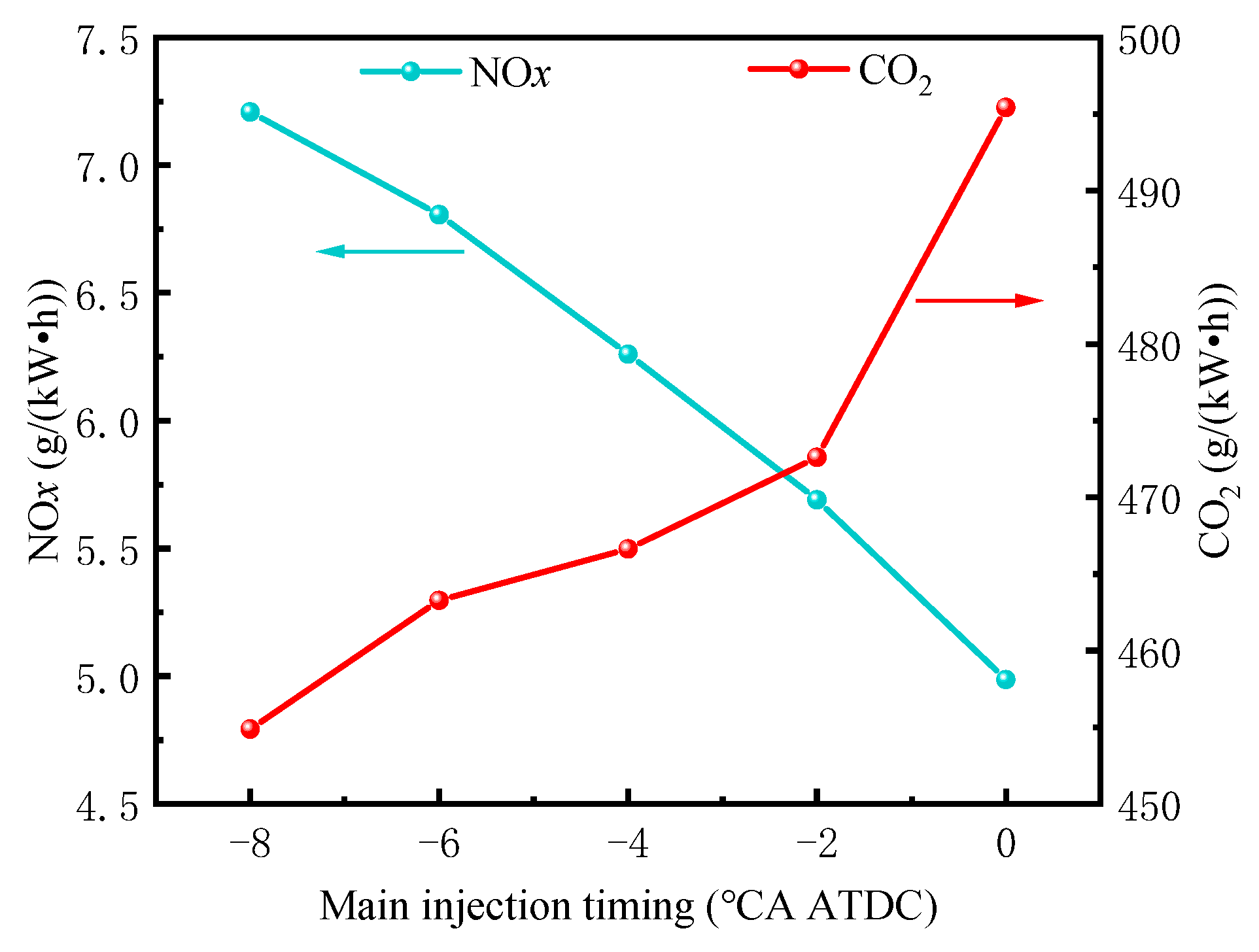
| Projects | Parameter |
|---|---|
| Rated power (kW) | 115 |
| Compression ratio | 16.6:1 |
| Rated speed (rpm) | 3200 |
| Maximum torque (N·m) | 450 |
| Maximum torque speed (rpm) | 1800 |
| Cylinder diameter × stroke (mm) | 95 × 105 |
| Air intake form | Supercharged intercooling |
| Engine displacement (L) | 2.977 |
| Fuel injection system | High-pressure common rail direct injection |
| Rail pressure (MPa) | 0–200 |
| Cooling mode | Water cooling |
| Property Fuel | Hydrogen | Diesel Oil |
|---|---|---|
| Main components | H2 | C10–C21 |
| C Mass fraction % | 0 | 86–89 |
| H Mass fraction % | 100 | 12.6 |
| O Mass fraction % | 0 | 0–0.4 |
| Density (kg·m−3) | 0.09 | 840 |
| Theoretical air–fuel ratio | 34.3 | 14.3 |
| Low heat value (MJ·kg−1) | 120.9 | 42.5 |
| Flame-propagation speed (m·s−1) | 3 | 0.42 |
| Minimum ignition energy (MJ) | 0.02 | 0.25 |
| Fire limit (%) | 4–75 | 0.6~6.5 |
| Diffusion coefficient (cm2·s−1) | 0.63 | — |
| Flame quenching distance (mm) | 0.64 | — |
| Device Name | Model Number |
|---|---|
| Transient fuel consumption meter | FCMA |
| Measure and control instrument | EIM609 |
| Atmospheric simulation integrated measurement and control system | CEM101 |
| Hydrogen flowmeter | CMFS025MB67N4BPMKZZ |
| Combustion analyzer | AVL 622 |
| Fourier transform multicomponent gas analyzer | AVL FTIR i60 |
| Operation Point | Maximum Hydrogen-Doping Pulse Width (ms) | Maximum Hydrogen Substitution Rate (%) |
|---|---|---|
| 30% load | 12 | 60 |
| 50% load | 10 | 35 |
| 70% load | 10 | 28 |
| 90% load | 8 | 15 |
| Research Parameters | Load/% | Maximum Hydrogen Substitution Rate/% | Preinjection Timing/°CA ATDC | Main Injection Timing/°CA ATDC | EGR Rate/% |
|---|---|---|---|---|---|
| impact of EGR rate | 90 | 15 | −18.6 | −4 | 0, 5, 10, 15 |
| impact of main injection timing | 90 | 15 | −18.6 | 0, −2, −4, −6, −8 | 0 |
Disclaimer/Publisher’s Note: The statements, opinions and data contained in all publications are solely those of the individual author(s) and contributor(s) and not of MDPI and/or the editor(s). MDPI and/or the editor(s) disclaim responsibility for any injury to people or property resulting from any ideas, methods, instructions or products referred to in the content. |
© 2023 by the authors. Licensee MDPI, Basel, Switzerland. This article is an open access article distributed under the terms and conditions of the Creative Commons Attribution (CC BY) license (https://creativecommons.org/licenses/by/4.0/).
Share and Cite
Liu, X.; Liu, S.; Shen, L.; Bi, Y.; Duan, L. Study on the Effects of the Hydrogen Substitution Rate on the Performance of a Hydrogen–Diesel Dual-Fuel Engine under Different Loads. Energies 2023, 16, 5971. https://doi.org/10.3390/en16165971
Liu X, Liu S, Shen L, Bi Y, Duan L. Study on the Effects of the Hydrogen Substitution Rate on the Performance of a Hydrogen–Diesel Dual-Fuel Engine under Different Loads. Energies. 2023; 16(16):5971. https://doi.org/10.3390/en16165971
Chicago/Turabian StyleLiu, Xiaole, Shaohua Liu, Lizhong Shen, Yuhua Bi, and Longjin Duan. 2023. "Study on the Effects of the Hydrogen Substitution Rate on the Performance of a Hydrogen–Diesel Dual-Fuel Engine under Different Loads" Energies 16, no. 16: 5971. https://doi.org/10.3390/en16165971
APA StyleLiu, X., Liu, S., Shen, L., Bi, Y., & Duan, L. (2023). Study on the Effects of the Hydrogen Substitution Rate on the Performance of a Hydrogen–Diesel Dual-Fuel Engine under Different Loads. Energies, 16(16), 5971. https://doi.org/10.3390/en16165971




